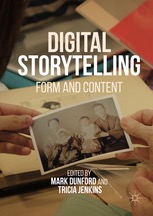teaching methods
Select an item by clicking its checkbox
How do theological educators help students face the constant reality of failure? Picture this scenario: a second career divinity student suffers health and financial troubles that impede her studies. The impact of these issues revives past psychological wounds. Enduring this morass of difficulties leads to the student’s failure in ...

Digital Storytelling Form and Content
Date Reviewed: May 17, 2018
Upon reading the varied chapters that constitute Digital Story Telling: Form and Content, I could not help but be reminded of Salman Rushdie’s comments on the power of story.
Those who do not have the power over the story that dominates their lives, the power to retell it, rethink it, deconstruct it, joke about it, and change it as times change, truly are powerless, because they cannot think new thoughts. (1991, Dec. 12, New York Times)
Rushdie’s words illustrate the demands the postmodern world places on all individuals. It is a world replete with a multiplicity of stories in a myriad of forms… stories of domination and liberation, state narratives and personal accounts, corporate media renderings, and cellphone videos. In this world, the personal and political are not easily divorced. It is a world eager for new mediums which can offer the individual tools for agency and a space in which to tell, retell, rethink, deconstruct, joke about, and change their story. Digital Storytelling (DS) appears to be one such medium.
What is DS? This volume’s editors, Mark Dunford and Tricia Jenkins, describe it as “a simple, creative process whereby people with little or no experience of computers gain the skills needed to tell a personal story as a two minute video using predominately still images combined with recorded voice-over, and often including music and/or other sounds” (3). The end products are “self-representational stories which emerge from a collaborative workshop process using a ‘Story Circle,’ in which a range of writing stimuli and other activities are used to develop trust within the group and ‘find’ the story” (3). Much of this definition comes from a pioneer in the field of DS, Joe Lambert, whose Digital Storytelling workshops, terminology, and methods have shaped the DS movement.
DS is a form of participatory media in which political activism is embedded in its very practice. Lambert describes how in the 1990s he and those he was working with “thought of the Internet, new low-cost digital media production tools, and the distribution opportunities of the web as major advances that could promote global democracy and liberation” (22). The advent of the Internet for such a medium is tantamount to the proliferation of the printing press in sixteenth-century Europe. One need only look to social media platforms such as Facebook, YouTube, and Instagram to see how the Internet and low-cost media production tools have changed what we watch and how we watch it. DS is a precursor to this platform proliferation and the motivations driving it as a process appear to have been less fiscally motivated. One of the paramount intentions of DS is to provide the voiceless the means to be heard. Of course, DS workshops have facilitators and funders, both of which, intentionally or not, are intimately involved in the creation and dissemination of these personal stories.
The volume is segmented into four elements or parts: Practice (five case studies from Kenya to the UK of DS in action); Content (pieces addressing the role content, especially content of a political [Simsek] or socially provocative [Kuga Thas] nature, plays in how that content is created, collected, received, parsed, and disseminated [Lewis and Matthews] and licensed [Spurgeon]); Form (insights garnered from when the cultural specificity of the DS model requires modification such as in Japan, Romania, and Ireland); and Understanding (three essays honing in on the limits and potential of DS as a political and personal force in the world).
The volume culminates with Nancy Thumim’s chapter “Therapy, Democracy, and the Creative Practice of Digital Storytelling” in which she reflects on the unifying themes of the book (DS as democratizing work, DS as therapy, DS as meaning-making, reflection, presentation, and representation) as well as the logistical and ethical challenges DS faces (issues of ownership in regard to co-created media, the afterlife of created materials, restructuring workshops to accommodate participants of disparate backgrounds and differing needs). DS, in its varied iterations, straddles the personal and public and opens up a space for creativity among communities created by the DS workshops and those affected by their material output (artifacts).
Perhaps the most compelling aspects of this volume are the stories (as found in Rainbird, Henry, Hardy and Sumner, Lewis and Matthews, Ogawa and Tsuchiya, Alexandra, and Brushwood Rose) of those persons challenged with mediating and assisting others (often those whose voices go unheard) through the process of narrating their own stories. As an academic advisor, the power of storytelling for self-actualization is readily apparent to me. Like the DS workshop facilitators in this book, academic advisors are involved in a co-creative narrative process. Advisors help students reflect on their goals and values and provide them with tools and mechanisms for authoring their own academic life story. The examples of DS workshop facilitators agonizing over how active to be in the creation of these personal stories should resonate with any reader who works in a co-creative capacity (advisors, administrators, teachers, parents, therapists, and so forth). The stories presented in each of these chapters are rather remarkable and, indeed, powerful. Anyone interested in modern media, narrative, social activism, communication studies, film, as well as those versed in DS scholarship, will find this a compelling read.
Over the past few years, I’ve come to cherish the opportunity to observe others teach. Teaching my own courses, I don’t get the chance to do this as much as I would like, but it’s one of my favorite parts of the profession. I love a good ...
Over the past few months, the entries in this blog series have attempted to provide guidance and insight related to the pedagogical challenges of teaching traumatic materials. The series was initiated to provide a sense of reassurance about facing these challenges. By discussing the range of challenges, the variety of ...
I don’t recall ever meeting anyone who sought out their own trauma. Those most prepared for the causal event were still caught unawares. As I’ve said before, trauma insists on passivity. That’s why I am a bit weary of valorizing people who did the so-called right thing ...


